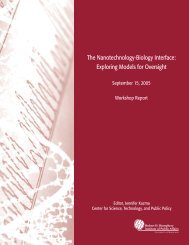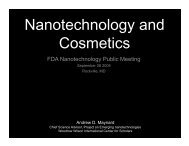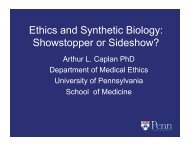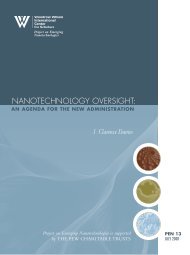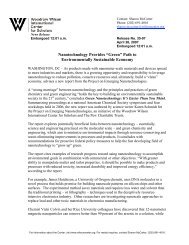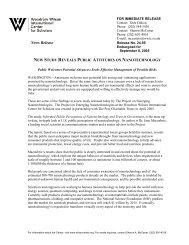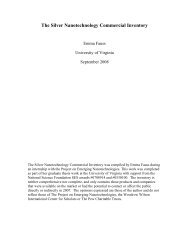Analysis of Nanotechnology from an Industrial Ecology ... - denix
Analysis of Nanotechnology from an Industrial Ecology ... - denix
Analysis of Nanotechnology from an Industrial Ecology ... - denix
Create successful ePaper yourself
Turn your PDF publications into a flip-book with our unique Google optimized e-Paper software.
Reference<br />
Steinfeldt et al.<br />
2004<br />
Steinfeldt et al.<br />
2004<br />
Steinfeldt et al.<br />
2004<br />
Year <strong>of</strong><br />
Study,<br />
Location<br />
Not<br />
indicated<br />
Germ<strong>an</strong>y<br />
Not<br />
indicated<br />
Germ<strong>an</strong>y<br />
(with use<br />
<strong>of</strong> U.S.<br />
study<br />
data)<br />
Not<br />
indicated<br />
Germ<strong>an</strong>y<br />
Sector<br />
Chemical<br />
/ Plastics<br />
Electroni<br />
cs/Displa<br />
y<br />
Lighting<br />
DRAFT - Inventory <strong>an</strong>d Evaluation <strong>of</strong> Life Cycle Assessments <strong>of</strong> N<strong>an</strong>otechnologies<br />
N<strong>an</strong>otech<br />
Product<br />
n<strong>an</strong>otube<br />
catalytic<br />
converter<br />
to produce<br />
styrene<br />
OLEDs<br />
<strong>an</strong>d CNT-<br />
FED flat<br />
displays<br />
compared<br />
to CRT,<br />
LCD, <strong>an</strong>d<br />
plasma<br />
displays<br />
Focus <strong>of</strong><br />
Study<br />
process<br />
innovation<br />
white n<strong>an</strong>oapplicatio<br />
LEDs <strong>an</strong>d<br />
qu<strong>an</strong>tum ns <strong>an</strong>d<br />
dots ecoefficiency<br />
compared<br />
to<br />
convention<br />
al <strong>an</strong>d<br />
energy<br />
saving<br />
light bulbs<br />
Approach<br />
compared to<br />
water-based,<br />
solvent-based,<br />
<strong>an</strong>d powder<br />
varnishes)<br />
deduction using<br />
a "general<br />
outline <strong>of</strong> the<br />
technology"<br />
n<strong>an</strong>oinnovation<br />
comparison <strong>an</strong>d<br />
qualitative<br />
s <strong>an</strong>d ecoefficiency<br />
for CRT <strong>an</strong>d<br />
LCA estimates<br />
LCD <strong>from</strong><br />
Socol<strong>of</strong> et al.<br />
2001<br />
Life Cycle<br />
Phases<br />
Included<br />
<strong>of</strong> surface,<br />
Varnishing,<br />
Use, End-<strong>of</strong>-<br />
Life<br />
Focus on<br />
Process;<br />
Used process<br />
energy data<br />
to estimate<br />
overall life<br />
cycle energy<br />
use<br />
Pre-<br />
Production,<br />
Production,<br />
Use<br />
Tech Benefits<br />
other coatings<br />
increased<br />
energy<br />
efficiency<br />
increased<br />
energy<br />
efficiency,<br />
higher<br />
resolution <strong>an</strong>d<br />
brightness, full<br />
color,<br />
lightweight, low<br />
cost<br />
Not indicated Use High energy<br />
intensity <strong>an</strong>d<br />
broad visible<br />
array; multiple<br />
applications<br />
Environmental<br />
Benefits<br />
emissions; 30% lower<br />
GHG emissions; lower<br />
acidification potential<br />
Environmental<br />
& Other Costs<br />
50% lower energy use potential risks<br />
during styrol synthesis <strong>from</strong> the use <strong>of</strong><br />
(325 MJ/kg using a n<strong>an</strong>otubes<br />
n<strong>an</strong>otube catalytic (need to be<br />
converter vs. 636 MJ/kg assessed)<br />
with classic styrol<br />
synthesis); 8-9% lower<br />
energy use over the<br />
entire life cycle;<br />
reduction in heavy<br />
metal use <strong>an</strong>d<br />
associated emissions<br />
greater material <strong>an</strong>d<br />
energy efficiency; lower<br />
production input for<br />
OLEDs; 2X greater<br />
energy efficiency in use<br />
phase compared to<br />
conventional LCDs;<br />
20% lower energy use<br />
over entire life cycle<br />
compared to LCDs<br />
white LEDs more<br />
energy efficient th<strong>an</strong> the<br />
classical light bulb;<br />
white LEDs only more<br />
efficient th<strong>an</strong> energy<br />
saving bulbs when they<br />
reach light efficiency <strong>of</strong><br />
over 65 lm/W; energy<br />
efficiency expected with<br />
qu<strong>an</strong>tum dots in the<br />
future<br />
signific<strong>an</strong>t risks<br />
not expected<br />
white LEDs 3X<br />
less efficient<br />
th<strong>an</strong> <strong>an</strong> energy<br />
saving light bulb<br />
Life Stages<br />
with Greatest<br />
Benefit a<br />
lightweight<br />
material)<br />
compared to<br />
other coatings<br />
Production<br />
compared to <strong>an</strong><br />
iron-oxide<br />
catalytic<br />
converter<br />
Use<br />
Use compared<br />
to classical light<br />
bulb<br />
Life Stages<br />
with Least<br />
Benefit a<br />
Not indicated<br />
Pre-Production<br />
Use compared<br />
to energy<br />
saving light<br />
bulb<br />
Notes: CF = Color Filter; CNT-FED = Carbon N<strong>an</strong>otube Field Emitter Display; LCA = Life Cycle <strong>Analysis</strong> or Assessment; LCD = Liquid Crystal Display; LCI = Life Cycle Inventory; LED = Light<br />
Emitting Diode; OLED = Org<strong>an</strong>ic Light Emitter Display; PGM = Platinum-Group Metal; TFT = Thin Film Tr<strong>an</strong>sistor.<br />
a Compared to other technologies.<br />
11



